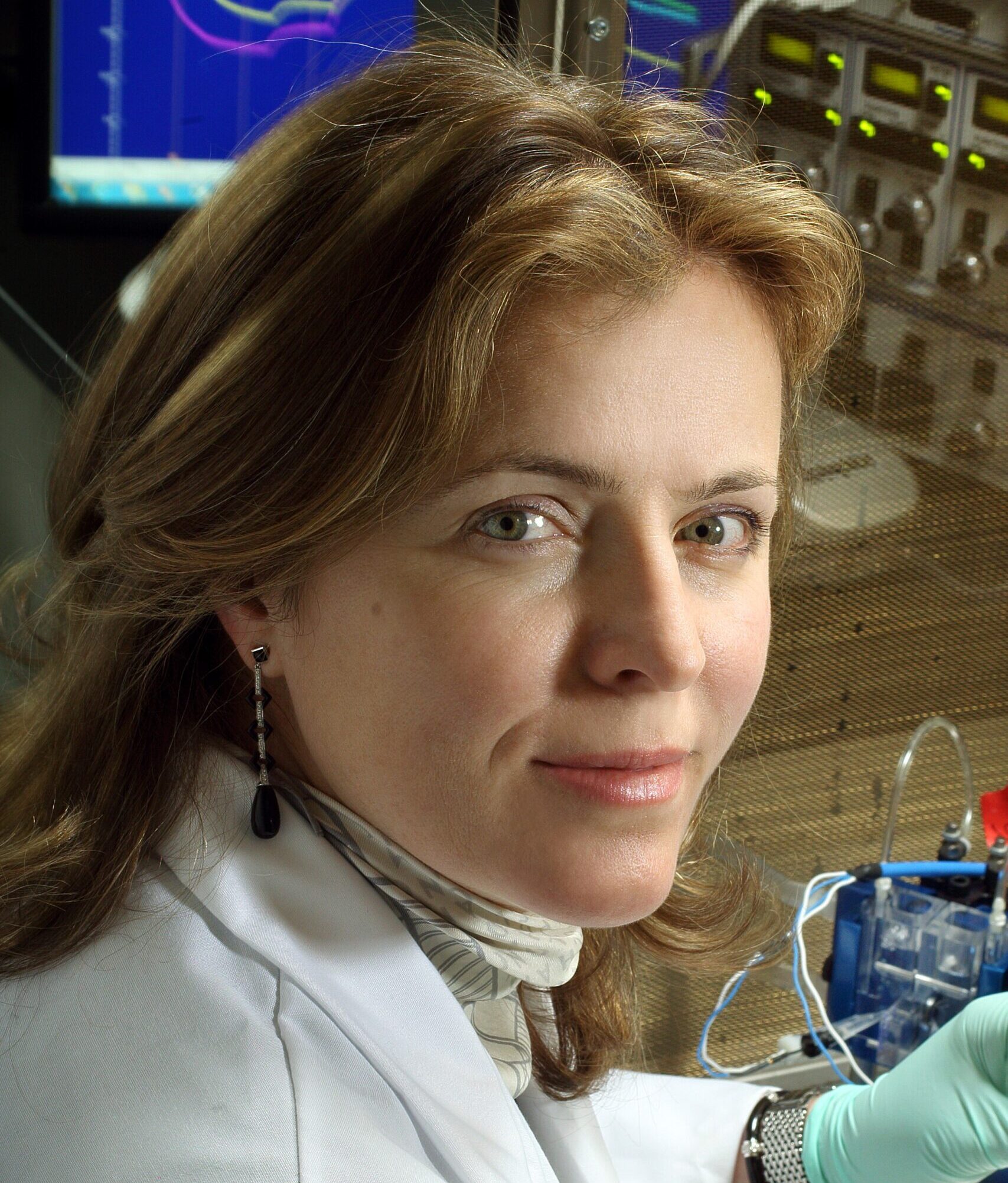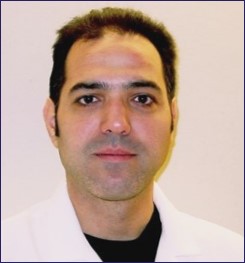Current funded research
In 2022, we awarded new research funding to 11 outstanding PKD researchers. In 2023, we’ve increased that number to 13! The goal of the Research Grant and Fellowship Programs will fund critical research to increase understanding of the genetic and pathological processes involved in PKD and to accelerate the development of potential therapies for PKD patients.
The review process
The Review Committee was comprised of the PKDF Scientific Advisory Panel (SAP), additional ad hoc scientists and experts in PKD, as well as a Stakeholder Review Panel made up of PKD patients and caregivers. Each application was assigned three independent reviewers who ranked the grants based on our Guidance for Reviewers that provided separate criteria for scientists and stakeholders. Read more about our Peer Review Process here.
Rankings were based on:
- significance to PKD research
- innovation
- investigator strengths
- scientific environment
- approach.

View more grant and fellowship awardees
2023 research grant awardees
We are excited to share with you the ten grants and three fellowships selected for funding in 2023.

2023 Dr. Vincent H. Gattone Research Award
Katharina Hopp, Ph.D.
University of Colorado Denver
Project Summary
GLP-1R agonists as novel therapeutic option for ADPKD
Studies of patients with overweight or obesity and Autosomal Dominant Polycystic Kidney Disease (ADPKD) show that body mass index (BMI) or abdominal fat mass are an important predictor of the rate of kidney cysts growth. Also, we recently found that efficacy of tolvaptan decreases with increasing abdominal fat mass. Hence, achievement and/or maintenance of a healthy BMI appears to be an important clinical target in the management of ADPKD. However, behavioral interventions to reduce BMI often fail due to low efficacy and challenges in adherence or tolerability. Further, weight loss is not a viable therapeutic option for patients with normal BMI and ADPKD as it provokes health risks such as bone loss, decreased immune function, or anemia, to name a few. Long-acting glucagon-like peptide 1 receptor agonists (GLP-1Ra[s]) are a highly effective next generation therapy that is changing management of patients with chronic obesity and/or type 2 diabetes. Beyond their weight loss and their regulatory role in glucose metabolism, GLP-1Ras have also been described to lower systemic and organ inflammation as well as cellular stress caused by reactive oxygen species. Since kidney cyst growth has been shown to be modulated by dysregulated glucose metabolism, inflammation, kidney immune cell function, and oxidative stress, we hypothesize that GLP-1Ras are an attractive and plausible therapeutic approach in ADPKD. Critically, this is independent of their effect on reducing BMI; meaning, we believe that GLP-1Ras may present a novel therapeutic approach even in patients with a healthy BMI, low abdominal adiposity, and ADPKD. In our preliminary studies we have established a diet-induced-obesity (DIO) ADPKD model using mice with a mutation to Pkd1 resulting in ADPKD phenotypes that mimic human disease. This DIO ADPKD model has significantly increased body weight and fat mass as well as more severe cystic kidney disease, paralleling the clinical findings. In addition, we found that DIO drives an increase in numbers of kidney immune cells that have been implicated to augment kidney cyst growth. In this application, we will test the therapeutic potential of semaglutide, a well-tolerated, FDA-approved GLP-1Ra, in slowing PKD progression using our established DIO ADPKD1 model. In addition, we will test semaglutide efficacy in the same ADPKD1 model, however, with mice being of healthy body weight. We will also include a group of mice which will receive no drug, but whose food intake is matched to that of the semaglutide group to control for the secondary effect that reduced food intake, known to occur with GLP-1Ra use, has on PKD progression. At the end of study, we will assess various commonly used preclinical parameters that establish severity of PKD which include total kidney volume measured by magnetic resonance imaging, kidney fibrosis and cystic burden evaluated on tissues sections of dissected kidneys, and kidney function. As a secondary outcome, we will also evaluate changes to vascular function using ultrasound imaging approaches that measure aortic stiffness. This secondary outcome is being considered because oxidative stress is known to impact cardiovascular health, which is compromised in patients with ADPKD and presents the most common cause of mortality. In addition, we will use a multitude of sophisticated methods that will allow us to understand the mechanisms through which semaglutide may impact PKD severity. These include assessment of abdominal adipose tissue function and secretion of proinflammatory factors, systemic and kidney metabolism, as well as kidney immune cell function and kidney- as well as vascular cell oxidative stress. Together, our study will be the first, to our knowledge, that tests the efficacy of a GLP-1Ra to slow kidney cyst growth using a clinically relevant disease model with or without obesity, building the foundation for clinical translation. The mechanistic studies will provide additional insight into relevant pathways that are modulated by GLP-1R signaling and may identify new alternate targets for treatment approaches as well as biomarker studies. Finally, our study will provide novel insight into the role of adipose tissue remodeling in PKD progression, an organ that has been poorly studied to date in PKD. All in all, this study addresses the PKD Foundation special consideration areas of “lifestyle interventions”, “PKD drug discovery”, and “extra-renal manifestations of PKD”.
Biography
Dr. Katharina Hopp, Ph.D., is an Assistant Professor at the University of Colorado Anschutz Medical Campus, Department of Medicine, Division of Renal Diseases and Hypertension. She has researched PKD pathomechanisms for the last 15 years predominantly utilizing rodent models. She completed her graduate work in Biochemistry and Molecular Biology with a focus on PKD genetics under the guidance of Dr. Peter Harris, Mayo Clinic, Rochester, MN. Since her move to CU Anschutz, her research program has focused on understanding the interplay between immune cells and the cystic epithelium. In particular, she is interested in understanding whether dysregulated metabolism, as characteristic for PKD, impacts immune cell function and if dietary/metabolism-based approaches can prime immune cells in functioning to slow kidney cyst growth. In her free time, Dr. Hopp enjoys exploring the Rocky Mountains with her family via camping, hiking, and running.

2023 Young Investigator Award
Kai He, Ph.D.
Mayo Clinic
Project Summary
Exploring the roles of axoneme polyglutamylation in the context of PKD
Inherited renal cystic diseases represent the most common human genetic diseases, including the ADPKD, ARPKD, the overlapping autosomal dominant polycystic liver diseases (ADPLD), and many syndromic forms of PKD, such as ciliopathies. ADPKD is the major form of PKD that mainly caused by mutations in PKD1/2 (encodes polycystin-1/2 or PC1/2) genes. Currently, tolvaptan, the only FDA-approved drug for ADPKD treatment, slows the disease by an indirect mechanism. However, it is only applicable for the patients with certain criteria and has substantial side effects. Optimal therapies capable of preventing diseases development or stopping their progression do not yet exist. Thus, drugs for treating PKD with wide spectrum of applicability and limited side effects are urgently needed.
Although the molecular mechanism of renal cystogenesis is still controversial, accumulating evidence suggest that the severity of PKD is closely correlates with the decreased functional dosage of polycystins. The primary cilium is a sensory antenna with central roles in sensing environmental cues and transduction of a variety of pivotal cellular signals. Polycystin complexes are hypothetically localize on primary cilia to inhibit renal cyst growth. Recent studies suggest that defective ciliary localization is one of the key mechanisms for decreased functional dosage of polycystins and cystogenesis in ADPKD, ARPKD, and PLD. Therefore, restoring the ciliary level of polycystins holds a strong therapeutic potential for these diseases but, unfortunately, without available molecular targets or drugs for that purpose.
Polyglutamylation (PG) is one of the tubulin posttranslational modifications that occur predominantly on cilia axoneme. Here, we propose that targeting axoneme PG could be a feasible and safe and therapeutic target for PKD for these reasons: 1) Axoneme PG controls the ciliary dosage of polycystins. 2) Increasing axoneme PG suppresses renal cyst growth in ex-vivo model of ADPKD. 3) Mouse genetic models with increased tubulin PG exhibit no noticeable physiological defects. 4) The proteins that control axoneme PG (enzymes, kinases, phosphatases) are conceptually druggable. However, there is no drug available to target axoneme PG and little is known about how axoneme PG is regulated.
Our preliminary studies identified a novel regulatory pathway for proper axoneme PG, targeting which increases ciliary polycystins and suppresses ex-vivo renal cystogenesis. Here, our proposed study aims to 1) further investigate the regulatory mechanism of axoneme PG. 2) screen small molecules, especially the existing clinical and preclinical drugs, to promote axoneme PG and increase ciliary polycystins. 3) determine the therapeutic effects of targeting axoneme PG in ADPKD. These studies will not only advance the knowledge of the regulatory mechanism of cilia function from basic science aspect, but also discover new targets and drugs to manipulate axoneme PG and ciliary polycystins. Importantly, completing the proposed studies could also discover a novel therapeutic strategy for PKD.
Biography
Kai He, Ph.D., is an Assistant Professor in the Department of Biochemistry and Molecular Biology at the Mayo Clinic. He received his Ph.D. in Biochemistry and Molecular Biology from the Shanghai Institute of Biochemistry and Cell Biology, Chinese Academy of Sciences, and postdoctoral training at the Mayo Clinic. He has received fellowship from the PKD Foundation, and the Outstanding Trainee Award from the Chinese American Society of Nephrology. Cilia-related diseases (ciliopathies) are life-threatening disorders that affect multiple organs. Manifestations include polycystic kidney and liver, obesity and diabetes, skeletal malformation, cardiovascular diseases, and brain anomalies. Despite the importance of primary cilia in human health, how cilia and ciliopathy protein function remains poorly defined. Dr. He’s research program has focused on the molecular basis of tightly regulated cilia function and its implications in ciliopathies. Dr. He also dedicates to identify small molecules to specifically target primary cilia and assess their therapeutic potential in the context of ciliopathies, especially in PKD.

Karam Aboudehen, Ph.D.
SUNY at Stony Brook
Project Summary
Deciphering the role of the long noncoding RNA Pvt1 in ADPKD
Despite remarkable advances in our understanding of ADPKD in the last few decades, the disease still has a devastating impact on affected families and society in general. Every year, thousands of people are diagnosed with ADPKD worldwide; therefore, there is an urgent need to further investigate the molecular mechanisms and develop more effective therapies that can positively impact the life and health of individuals with ADPKD. Long noncoding RNAs (LncRNAs) are a class of non-protein coding RNAs with pivotal functions in development and disease. They have emerged as an exciting new drug target category for many common conditions. However, the role of lncRNAs in ADPKD has been understudied. This proposal will determine the impact of a known, highly conserved, and pathogenic lncRNA, called PVT1, on ADPKD pathogenesis. Our proposed assays are based on strong preliminary data showing that Pvt1 silencing reduces cyst growth in cultured kidneys from Pkd1-null mouse embryos. We will utilize pre-clinical models of mouse and human ADPKD to determine whether inhibition of PVT1 ameliorates cystogenesis. One protein that is known to be regulated by PVT1 and plays a critical role in advancing ADPKD is c-MYC. c-MYC is an attractive drug candidate; however, targeting c-MYC remains a challenge. Our proposal provides a complementary approach to traditional drug development in ADPKD. This approach focuses on targeting a single lncRNA to manipulate multiple genes, proteins, and pathways. Should we succeed, it would open the door for exploring the therapeutic potential of inhibiting PVT1 and reducing c-MYC levels to ameliorate cystogenesis in ADPKD.
Biography
Karam Aboudehen is an Assistant Professor in the Department of Medicine, Division of Nephrology, at Stony Brook University (SBU). In 2012, he completed his graduate training at Tulane University under the guidance of Dr. Samir El-Dahr in Pediatric Nephrology. He then joined Dr. Peter Igarashi laboratory as a post-doctoral fellow at the University of Texas Southwestern Medical Center in Dallas. In 2016, Dr. Aboudehen was appointed to a faculty position at the University of Minnesota before recently joining the Nephrology Division at SBU in 2022. Research in Aboudehen’s lab focus on investigating the role of long noncoding RNAs (lncRNAs) in polycystic kidney disease (PKD). The long-term objective is to discover therapeutically targetable lncRNAs that prevent or mitigate cyst formation and/or progression in PKD. His lab utilizes cutting edge technologies that include mouse molecular genetics, next generation sequencing and mass spectrometry, genetic engineering, RNA pulldown assays, and viral gene delivery.

Christopher Banek, Ph.D.
University of Arizona
Project Summary
Renal Innervation and Nerve Activity Influence on Cystic Progression in ARPKD
Polycystic kidney disease (PKD), both autosomal dominant (AD) and autosomal recessive (AR) forms, remains the leading cause of inheritable kidney disease in adults and children throughout the world. PKD is defined by the development of non-cancerous neoplasms (i.e. fluid-filled sacs) that grow overtime and progressively cause kidney failure. Though the cause of renal cyst formation is well-understood to be primarily driven by an inherited or spontaneous genetic mutation, there remains no cure beyond kidney transplantation. Since access to kidney transplantation is extremely limited, it is vital to this patient population to study alternative strategies for treatment. In recent years, there has been a very important advancement in drug therapy, known as Tolvaptan, that interrupts the vasopressin type 2 receptor (V2R) in the kidney. This receptor contributes to cyst growth in PKD, and Tolvaptan has been shown to slow cyst progression and, in turn, kidney failure. While promising Tolvaptan serves as an excellent intervention currently, there are notable side effects that decrease a patient’s quality of life, such as excessive thirst (polydipsia) and urination (polyuria) – all day and all night. Our laboratory is focused on targeting the same pathway through the kidney’s nervous system, which is known to regulate kidney function and potentially V2R signaling.
The kidney is innervated with many nerves that relay signals to the kidney from the brain (efferent nerves), and from the kidney to the brain (afferent nerves). In several preclinical studies in other models of kidney disease, the activity of these kidney nerves is increased compared to healthy controls. If these signals are disrupted by surgically cutting these nerves, many models of kidney disease are improved. This procedure is referred to as renal (i.e. kidney) denervation (RDNx). Most excitingly, our lab has recently reported that performing the RDNx procedure in a rat model of PKD slows cyst growth. Notably, there were no effects on water intake or urination volumes, which may be preferential to the side effects noted earlier with Tolvaptan. While these early results are promising indeed, further research is required to understand the molecular pathways affected by the RDNx procedure before advancing this new treatment to clinical trials.
A few outstanding questions remain regarding the effect of RDNx. Firstly, it remains unknown if there are direct effects on the V2R signaling in the kidney. The experiments outlined in our proposal directly test this to see if this receptor is involved in the effects of RDNx. Secondly, it is unknown if kidney nerve activity is increased progressively as the cysts grow. We have carefully designed experiments to quantify the nerve signaling to determine when and if nerve activity is altered. This would be very valuable in determining when the RDNx procedure would be most effective. Finally, we will determine the if the beneficial effects of RDNx are dependent on the removal of the local proteins that are released at the ends of these nerves (i.e. neurotransmitters). This will determine whether the signal relayed to the brain is more important, or if the neurotransmitters contribute to the cyst progression.
Overall, Dr. Banek’s laboratory is well-experienced and equipped to run these studies at the University of Arizona and Sarver Heart Center. These studies are carefully designed to reveal the underlying mechanisms of the kidney’s nervous system and its contribution to PKD progression. If successful, RDNx and/or the underlying mechanistic targets may be quickly launched to the next stage for clinical translation to complement the severely limited tool chest for PKD treatment.
Biography
Christopher Banek, PhD is an Assistant Professor in the Department of Physiology at the University of Arizona College of Medicine in Tucson, AZ. Dr. Banek has an expansive training background in neuro, cardiovascular, and renal physiology, with a specific emphasis on hypertension and renal injury/inflammation. He received his PhD in Human Physiology from the University of Oregon, and completed a postdoctoral fellowship in cardiovascular physiology at the University of Minnesota Medical School. Throughout his career, Dr. Banek has focused on the physiological underpinnings of cardiovascular and renal disease – largely in the context of high blood pressure (i.e. hypertension) and kidney dysfunction. His recent studies have largely focused on the contributions of the kidney’s nervous system to the development and progression of polycystic kidney disease. Dr. Banek’s team recently published a study on the novel application of a targeted nerve ablation technique (renal denervation; RDNx) that disrupts the kidney’s nervous system in a model of autosomal recessive PKD, which reduced kidney cystic progression and blood pressure. Dr. Banek and his team are now focused on elucidating the underlying mechanisms and role of renal nerves in the progression of renal cysts, as well as the potential for RDNx as a novel therapeutic modality for PKD intervention.

Liudmila Cebotaru, M.D., J.D.
Johns Hopkins University School of Medicine
Project Summary
Developing a New Therapeutic Approach for Autosomal Recessive Polycystic Kidney Disease
Autosomal recessive polycystic kidney disease (ARPKD), caused by mutations in the PKHD1 gene (2,3), is a debilitating genetic disorder causing newborn morbidity and mortality. The most severe disease occurs when the fetus develops abnormal kidneys and a deficit in fluid surrounding the fetus (4). Those who survive to birth face a myriad of symptoms, including increased blood pressure and changes in the fine structure of the liver; they also develop dilations in portions of the kidney ultimately leading to its destruction (5). Management of the disease in infants who survive the first weeks of life is difficult, requiring extreme measures including kidney and/or liver transplant (6). Clearly, there is a critical need to develop treatments for ARPKD. We provide compelling data showing that an approved drug for cystic fibrosis, VX-809, reduces abnormal cyst growth in liver cells from ARPKD model mice. We propose the novel hypothesis that drugs used to treat cystic fibrosis can be used as a treatment for ARPKD and (7) can be fast-tracked for ARPKD treatment. The goal here is to provide a strong proof-of-principle and mechanistic background that will allow the drugs to move forward as a treatment for ARPKD and to establish a new paradigm based on restoring key mechanisms to reduce disease in the lungs, kidneys, and liver. Aim 1 will address the therapeutic potential of cystic fibrosis drugs by determining how they restore function in multiple models of ARPKD. Here we will evaluate a new therapeutic paradigm, using two mouse models to assess the ability of drugs to restore liver and kidney function to these animals. These experiments in rat and mouse models will provide the proof-of-principle that can be used to develop modulators into approved drugs for the treatment of ARPKD. Aim 2 will uncover novel mechanisms that lead to multiorgan disease in ARPKD. We have found three profound bodily functions that misfunction in ARPKD, which together may be targets for therapeutic intervention. In this Aim, we will address the contributions of each of these to the pathology associated with ARPKD. The goal is to define pathways in the body that lead to disease, thereby providing a mechanistic understanding of how modulator drugs work to reduce the dis-ease. An understanding of drug mechanism is not only important for clinical development but also for the development of additional medicines that might work even better.
Biography
Dr. Liudmila Cebotaru’s training in medicine began at the age of 18, when she received a R.N. degree from Medical College of Balti, Moldova. She continued her medical training by obtaining an M.D. degree from University of “Carol Davila” School of Medicine and Pharmacy of Bucharest, Romania, and then obtained further training in the areas of pathology. While studying medicine, she also successfully achieved a J.D. degree from the University of Bucharest, Law School and continued in the US, where she later received a Master’s Degree in US Law from the University of Baltimore. Her training in the U.S. began as a post-doctoral fellow at Johns Hopkins University in Gastroenterology and Physiology. She remained at JHU and was promoted to Associate Professor in 2017. In keeping with her training in both medicine and basic science, her passion is to understand the molecular basis of the disease process and to restore normal function to disease-causing mutant proteins. She strongly believes that by understanding the mechanism of the disease process at a basic level, we can devise strategies to correct or at least, bypass defective proteins and restore function. She is currently conducting extensive studies in developing gene therapies for Cystic Fibrosis and in the role of CFTR in Autosomal Dominant Polycystic Kidney Disease. As a result of her past studies on the mechanism of how the cell handles defective proteins and how to rescue function using CFTR modulators, she uncovered a potential new strategy for reducing liver and kidney disease in Autosomal Recessive Polycystic Kidney Disease.

Harrison Kim, Ph.D.
University of Alabama at Birmingham
Project Summary
Accurate assessment of intrarenal perfusion in ADPKD using quantitative DCE-MRI
To date, the best methods of identifying high-risk patients for rapidly progressive ADPKD are based on total kidney volume (TKV). However, TKV trajectories are typically not smooth even when followed yearly, and an accurate assessment of therapeutic response based on TKV may require several-year follow-ups. Thus, there is an urgent need to develop a more sensitive alternative for disease activity monitoring.
Intrarenal perfusion may serve as a robust indicator of ADPKD severity. ADPKD causes polycystin impairment in the renal endothelial cells, leading to vascular remodeling, ischemia, fibrosis, and, consequently, perfusion decrease. Dynamic contrast-enhanced magnetic resonance imaging (DCE-MRI) can non-invasively assess tissue perfusion by monitoring the dynamic change of MRI contrast agents. Macrocyclic gadolinium-based MRI contrast agents (e.g., gadoteridol) are known to be safe even in patients with stages 4 and 5 of chronic kidney diseases. The volume transfer constant (Ktrans), one of the quantitative DCE-MRI (qDCE) parameters, measures tissue perfusion.
However, the measurement variability across different MRI scanners remains a concern for the reproducible application of qDCE across various clinics. Each MRI vendor provides unique hardware configurations, pulse sequences, and reconstruction algorithms, which cause variations in quantitating tissue contrast agent concentration and DCE-MRI parameters. An external phantom with a known contrast agent concentration may allow us to detect and correct the variation. Furthermore, if the phantom is miniaturized to be imaged concurrently in the bore of a standard MRI scanner with a patient, the intra-scanner variability due to hardware instability can also be reduced.
We developed a point-of-care perfusion phantom named P4 (Point-of-care Portable Perfusion Phantom). The P4 phantom can be imaged with a human subject in a standard MRI scanner to reduce inter/intra-scanner variabilities. In our recent study, the intraclass correlation coefficient (ICC) of Ktrans measurement across three 3T MRI scanners in two clinics was improved from 0.38 to 0.99 after the P4-based error correction. The P4 phantom is inexpensive and ready to use in any commercially available MRI system without needing adjustment. Therefore, the P4 phantom is ideal for highly reproducible qDCE measurement of intrarenal perfusion.
We hypothesize that the intrarenal perfusion measurement using qDCE is highly reproducible when a P4-based error correction scheme is employed. We aim to test this hypothesis with an ADPKD patient cohort at the University of Alabama at Birmingham (UAB). The anticipated high reproducibility of the P4-based qDCE measurement will provide strong evidence for integrating this method into ADPKD clinical trials as a novel phenotypic readout. If successful, this technology will: a) improve precision in ADPKD risk stratification and prediction of outcomes, allowing more timely dose adjustment of therapeutics, and b) enable accurate data comparison across different MRI scanners, facilitating collaboration among institutes to develop advanced treatments for this devastating disease.
Biography
I am a professor in the Department of Radiology for the Division of Advanced Medical Imaging Research at the University of Alabama at Birmingham (UAB). My research vision is to globally standardize quantitative imaging of various diseases including polycystic kidney disease (PKD), which will facilitate automatic prognosis and therapy monitoring for patients. Automatic clinical decisions will drastically reduce the turnaround time and medical expenses for patients. My research mission is to develop hardware and software tools along with this initiative and validate those tools in multi-institutional clinical trials. In the proposed study, I will develop a novel prognostic imaging biomarker for PKD, which will be used for early therapy adjustment.

Ivana Kuo, Ph.D.
Loyola University Chicago
Project Summary
Cardiac-driven hypertension in Autosomal Dominant Polycystic Kidney Disease
Heart failure is the main cause of death in patients with Autosomal Dominant Polycystic Kidney Disease (ADPKD). One of the most significant preventative measures to reduce heart failure is to lower blood pressure. This is because the heart is a pump, and when the hose (blood vessels) become too tight, the buildup in pressure causes the pump to fail (i.e.: heart failure). High blood pressure (hypertension) affects over 70% of all ADPKD patients and is one of the earliest detectable symptoms of ADPKD.
Almost all ADPKD patients take medications that reduce blood pressure. However, many factors cause hypertension. These include things we can put into our body, like a high salt diet, or things inside our bodies, like a cystic kidney pushing on the kidney blood vessels. The kidney cysts start a vicious cycle where the kidneys release of a substance called renin. Renin causes the production of substances that cause the body to hold onto more salt, resulting in an even higher blood pressure. Most ADPKD patients receive medications called ACE inhibitors or ARBs that try to break the renin cycle and lower blood pressure. However, the heart can also release helpful factors, called natriuretic peptides, that lower a patient’s blood pressure. Natriuretic peptides are the body’s own way of trying to fix hypertension as they allow the heart and blood vessels to relax (thus reducing blood pressure) and cause the kidneys to excrete more salt in the urine. These combined effects of relaxation and decreased salt all reduce blood pressure. Our end goal is to see if we can help the hearts of ADPKD patients help their kidneys by producing more beneficial natriuretic peptides and ultimately reduce hypertension and heart failure.
Our mice which do not have polycystin 2 (one of the two genes which when mutated result in ADPKD) in the heart but have normal kidneys have profound hypertension. Excitingly, our studies suggest that the hypertension happens because the mice without polycystin 2 in the heart cannot produce natriuretic peptides. In this proposal, we have two goals that will help us better understand how loss of polycystins in the heart leads to hypertension and if existing FDA approved treatments that preserve natriuretic peptides can reduce hypertension in ADPKD.
Our first goal is to better understand how loss of polycystin proteins prevent the production of natriuretic peptides. We will test if polycystin 1 and polycystin 2 (the two genes which when mutated cause the majority of ADPKD) both contribute to the production of natriuretic peptides. Using modified heart cells grown in the laboratory, we will test different mutations to polycystin 1 and 2 that occur in ADPKD patients for their ability to produce natriuretic peptides. The impact of completing this goal is that we will know if patients with polycystin 1 or polycystin 2 mutations both have reduced natriuretic peptide production. This may help inform how a patient’s hypertension is developing and provide clinicians with opportunities to intervene.
Our second goal is to test in our hypertensive mouse if an already approved heart failure FDA drug (sacubitril/valsartan; marketed by Novatis as Entresto) reduces blood pressure. Entresto is a dual formation drug that keeps natriuretic peptides from breaking down in the body (sacubitril) and an ARB that targets the renin pathway (valsartan). This dual combination treatment may be more effective than the renin pathway drugs that are commonly prescribed to ADPKD patients.
For the ADPKD patient, these studies will be the first scientific test of how the polycystin proteins decrease natriuretic peptide production, and second, these studies will test an already approved FDA natriuretic peptide drug to reduce blood pressure. Ultimately, the hope is that we will have better hypertension treatments that also reduces heart failure in the ADPKD patient.
Biography
Dr. Ivana Kuo is an Assistant Professor in the Department of Cell and Molecular Physiology at Loyola University Chicago. She obtained her PhD in Neuroscience at the Australian National University, before studying the function of polycystin proteins in her postdoctoral work at Yale University in the Department of Pharmacology under the mentorship of Dr. Barbara Ehrlich. Dr. Kuo’s laboratory uses cell and mouse models to understand the cardiovascular manifestations within ADPKD, with a particular emphasis on how polycystin proteins in cardiomyocytes contribute to cardiac function.

Max Christoph Liebau, M.D.
University Hospital Cologne
Project Summary
Identifying clinical and biochemical risk markers of ARPKD liver disease
Autosomal recessive polycystic kidney disease (ARPKD) is a disorder, that typically presents with symptoms in childhood. The two organs that are mainly affected are the kidneys and the liver. Kidney disease in ARPKD results in enlarged cystic kidneys and impaired kidney function. Liver disease in ARPKD is characterized by inborn fibrotic changes of the liver and dilated bile ducts. While the fibrotic changes lead to congestion of the blood flow through the liver, the dilated bile ducts result in an increased risk of severe infection and inflammation for patients. Liver disease in ARPKD may result in a need for patient to undergo liver transplantation or combined liver and kidney transplantation. ARPKD is one of the two main reasons for combined liver and kidney transplantation in childhood.
Different from kidney disease in ARPKD, first symptoms associated with liver disease in ARPKD tend to present a bit later in childhood and may show progression until adulthood. For some patients the involvement of the liver may then even be more severe than kidney disease. However, it is not well-known why some patients with ARPKD develop a more pronounced form of liver disease than others and if there are early clinical, imaging or laboratory findings or disease patterns that could indicate a high risk to patients and caregivers at an early timepoint in life. It is also not well-understood, how different variants in the ARPKD-causing gene PKHD1 lead to liver disease.
In the past we have mainly studied risk factors of kidney disease progression in ARPKD. We identified first risk markers of rapid progression of kidney disease n childhood. These studies have facilitated the establishment of first clinical trials.
In the current project we aim to follow the same path for liver disease. We will use the existing data of more than 700 patients in the European ARegPKD registry, the largest clinical dataset on clinical longterm courses of patients with ARPKD collected so far. Using complex statistical workup methods we aim to identify risk markers at an early timepoint in young childhood that could help to predict the progression of liver disease. This could include ultrasound or other imaging findings, laboratory values, specific genetic variants or a combination of different markers.
In addition to the statistical workup of the clinical findings, we aim to identify blood markers of liver disease in ARPKD. In previous ARegPKD analyses we identified PKHD1 variants that are associated with variable degree of liver disease. We have used the novel molecular technique of CRISPR/Cas9 and have generated corresponding mouse models carrying exactly the same variants. We will characterize disease progression in these mouse models by studying liver tissue structure and protein expression profiles at different time points in an independent project. Bridging the work between clinical markers and laboratory studies we will now study potential novel serum biomarkers in the here suggested study. We have successfully established the technique of unbiased serum proteome analyses in Cologne and have deep pre-existing data on typical patterns in children with chronic kidney disease. For these studies a volume of 5µl is enough to perform the highly-specific analyses of around 300 proteins in serum at the same time. Serum proteins serve as biomarkers for many diseases and we hypothesize that there may be specific changes of serum markers due to liver disease in ARPKD that we can identify through this unbiased approach. We also hypothesize that early markers can differentiate between the disease patterns and that they can be helpful add-ons to clinical markers. Using the newly developed mouse models, we will analyse how serum proteome patterns change over time in mice with liver disease and/or kidney disease. In addition to studying the more clearly defined mouse models we will also perform proteome analyses of patient samples and will study associations with the clinical extent of liver and/or kidney disease documented in ARegPKD. In complex bioinformatical approaches we will integrate the findings from clinical observations and serum proteome measurements in a joint model that will help to improve prediction profiles for individual patients at a young age childhood.
This project could have impact for ARPKD research in multiple ways. It could help to identify subgroups of patients with liver disease that could be studied and compared more precisely in clinical trials. Here, clinical and biochemical markers could be combined and the risk for severe liver disease may be predicted more precisely thus supporting clinical decision-making. The project could also help to establish novel models to specifically study molecular mechanisms of liver disease development and progression in ARPKD, which could be helpful for future studies of therapeutic approaches.
Biography
Max C. Liebau, MD, is a clinical consultant pediatric nephrologist at the Department of Pediatrics at the University Hospital Cologne, Germany, where he holds positions as Head of the Social Pediatric Center for Chronically Ill Children and Head of Translational Pediatric Nephrology. Dr Liebau combines his clinical training as a pediatric nephrologist with his experience in cellular and molecular biology obtained in the Nephrology Research Laboratories in Freiburg and Cologne, Germany and at the University of California, Santa Barbara. His group follows a translational research approach to study genetic kidney diseases with a special focus on Autosomal Recessive Polycystic Kidney Disease (ARPKD). The group aims to understand the molecular function of the ARPKD protein fibrocystin and to characterize clinical long-term courses of ARPKD as a basis for the identification of clinical and/or biochemical risk markers of disease progression. Dr Liebau initiated and is currently leading the international ARPKD registry study ARegPKD and is a co-initiator of the pediatric ADPKD registry study ADPedKD. His research is funded by the German Research Council and the German Federal Ministry for Education and Research amongst others.

Pamela Tran, Ph.D.
University of Kansas Medical Center
Project Summary
A novel nutrient sensor pathway in ADPKD
Autosomal Dominant Polycystic Kidney Disease (ADPKD) is among the most common, life-threatening hereditary kidney diseases affecting approximately 1:1000 individuals worldwide. ADPKD causes progressive growth of large fluid-filled renal cysts, which causes kidney injury and can lead to end-stage renal disease. The disease also causes pain, hypertension, bladder infection, vascular complications and liver cysts. As such, the medical burden of ADPKD affects quality of life. There is one FDA-approved therapy, but it has variable effectiveness and multiple side effects. Thus, there is a need to increase our understanding of the mechanisms that drive ADPKD progression to devise new therapeutic strategies. The molecular etiology of renal cystogenesis is complex, but studies indicate the disease mechanism originates from a defect in the primary cilium. The primary cilium is a sensory organelle that converts chemical and mechanical cues into pathways that regulate cell homeostasis. Altered cellular metabolism has emerged as an important contributor to ADPKD pathogenesis, and studies suggest primary cilia and cellular metabolism connect. We propose that a nutrient sensor pathway acts both as a novel potential therapeutic target and molecular link between the ciliary and metabolic defects in ADPKD. Using a mouse model that mimics the slowly-progressive nature of the disease as well as our recently developed cell culture device that enables formation of in vitro 3D renal tubules comprised of patient-derived cells to evaluate the chemosensory function of ADPKD primary cilia, we anticipate our experiments will show that ADPKD renal cystogenesis is mitigated by inhibition of this nutrient sensor, and that novel regulatory mechanisms, feedback loops, and in turn, additional therapeutic targets will be revealed. Our 3D renal tubule mimetic creates a more physiologically relevant environment and can be used for future screening of pharmacological compounds. Thus, completion of this proposal will present a new therapeutic target and novel avenues to identify additional therapeutic strategies against ADPKD. This will contribute toward alleviating the immense medical burdens of this common genetic disease.
Biography
Pamela Tran, PhD, is an Associate Professor in the Department of Cell Biology and Physiology and in the Jared Grantham Kidney Institute at the University of Kansas Medical Center (KUMC). She is Co-Director of the In Vivo Models Core of the PKD-Research Resource Consortium at KUMC. For 20 years, she has been using genetic mouse models to investigate the role of primary cilia dysfunction in various diseases, such as PKD, obesity and skeletal disorders. In collaboration with other investigators at KUMC, her laboratory has found that a post-translational modification and regulator of metabolism, O-GlcNAcylation, is upregulated in ADPKD. This proposal seeks to explore a possible connection between increased O-GlcNAcylation and the ciliary defects in ADPKD.

Yan Zhang, Ph.D.
Michigan Technological University
Project Summary
The role of high mobility group box 1-induced NF-kappa B activation in polycystic kidney disease
Autosomal dominant polycystic kidney disease (ADPKD) is characterized by the formation and growth of numerous fluid-filled cysts and the development of tissue inflammation and fibrosis. Inflammation is a key driving force for cyst growth and tissue fibrosis of ADPKD. This study will help to understand the molecular mechanisms for the inflammation development of ADPKD and will test resolvins, newly discovered anti-inflammatory molecules, as a potential therapeutic approach to slow the disease.
Biography
Yan Zhang is a Research Assistant Professor in the Department of Biological Science at Michigan Technological University. Dr. Zhang earned her PhD in Pharmacology and Toxicology from the University of Missouri-Kansas City, and her work investigated the molecular mechanisms mediating “sterile” inflammation, demonstrating that toll-like receptors are required for endogenous damage-associated molecular patterns-mediated activation of innate immunity. After that, Dr. Zhang completed her postdoc training in Dr. Darren Wallace’s laboratory of Jared Grantham Kidney Institute at the University of Kansas Medical Center. Her research has focused extensively on identifying key regulators for cyst growth, interstitial inflammation, and fibrosis in PKD and novel therapeutic approaches to slow the disease. Her work showed that conditional overexpression of transforming growth factor-beta1 in collecting ducts increased cell proliferation, accelerated renal fibrosis and the decline of renal function, and shortened the lifespan of PKD mice. Her work also demonstrated that elevated Ca/Calmodulin-dependent kinase 4 in cystic epithelial cells is a novel upstream regulator of mTOR, a key regulator of cell proliferation and cyst growth in ADPKD. In addition, she examined the role of liver kinase B1 (LKB1), the primary upstream regulator of AMP kinases, in the disease progression of ADPKD and found that LKB1 is an important regulator of key pathways involved in cyst growth and fibrosis, and activation of LKB1 slows disease progression of PKD mice.
2023 fellowships

Sarah Miller, Ph.D.
University of Oklahoma, Health Sciences Center
Project Summary
The Role of Trem2+ Cyst Associated Macrophages in Polycystic Kidney Disease
Polycystic kidney disease (PKD) affects over half a million people in the United States and is one of the most common genetic kidney diseases. The disease is characterized by gradual development of kidney cysts throughout a patient’s lifetime, which eventually leads to end-stage kidney disease requiring renal replacement therapy or transplant. The slow progressing nature of autosomal dominant PKD (ADPKD) means there are opportunities for pharmacological or behavioral interventions aimed at slowing disease progression. Data from multiple studies indicate that a type of immune cell in the kidney, called macrophages, promote cyst progression in animal models of the disease. However, the majority of data that supports these findings was collected using rapidly progressing congenic (i.e. born with the disease) or injury accelerated (i.e. mice are given a renal injury to make cysts grow faster) models of disease. This equates to studying the role of macrophages during 0-10 (congenic) or 16-24 years of age (injury accelerated) in humans. This does not accurately reflect the timing (age of cyst onset) or rate of disease progression (slow) in humans, where cysts begin to enlarge in the 2nd decade of life and gradually progress until end stage renal disease is reached in the 5th-9th decade. In preliminary studies, I analyzed the gene expression profiles of kidneys from both slowly and rapidly progressing models of cystic disease as well as non-cystic controls. My data identified a major difference in the macrophage profile between slow and rapid cystic models and non-cystic controls. This included a population of cyst associated macrophages (CAM) that were only present in the slowly progressing model that expressed the gene Trem2. Based on data showing a protective role for Trem2+ macrophages in other slowly progressing diseases, I hypothesize that Trem2+ CAMs restrict cyst growth. In this project I will use a slowly progressing mouse model (Pkd1RC/RC) that develops cystic disease at an age and rate similar to patients to determine the role of Trem2+ CAMs in a clinically relevant animal model. I will also test whether Trem2+ CAM macrophages are present in kidneys isolated from end stage ADPKD patients. Thus, these studies will challenge the central paradigm that all kidney macrophages promote PKD progression, and instead pursue the concept that there are beneficial subpopulations of macrophages that can help restrict cyst growth. The idea of enhancing protective macrophages which may directly inhibit cyst growth has the potential to be of significant translational value to the field as antibodies that enhance Trem2+ CAM activity are currently in clinical trials for patients with Alzheimer’s disease and may be rapidly repurposed for patients with ADPKD.
Biography
I am postdoctoral researcher working under the mentorship of Dr. Kurt Zimmerman in the Department of Internal Medicine, Division of Nephrology at the University of Oklahoma Health Sciences Center (OUHSC). During my graduate training in the lab of Dr. Jimmy Ballard, my work was primarily focused on the large clostridial toxin TcdB, produced by the bacteria Clostridioides difficile. During my studies, I found a 19-amino acid region in the toxin that, when deleted, prevented membrane translocation while leaving the toxin enzymatically active. This toxin mutant was used as a vaccine candidate in later studies and was found to elicit an immune response that was protective against disease in an animal model. This patented technology is currently being investigated for use in patients. As a result of my graduate studies, I have a strong background in microbiology, protein biology, and immunology.
As a postdoctoral researcher, my studies have focused on the intercellular crosstalk between the cystic epithelium and kidney resident macrophages. Using single cell RNA sequencing, I identified two possible clusters of cystic epithelium that shared expression of several genes, including Spp1. My spatial transcriptomics and RNA scope data confirm that Spp1 expression is strongly enriched in cystic epithelium. Further, loss of Spp1 worsened cystic disease suggesting that Spp1 restricts cyst progression, possibly through influencing macrophage accumulation and activation. The results of these studies are currently being assembled into a manuscript. My current project is focused on understanding how macrophages influence the progression of cystic kidney disease. In particular, I found that a specific subset of macrophages, termed Trem2+ cyst associated macrophages (CAM), was significantly enriched in mice with cystic kidney disease compared to non-cystic littermate controls. To test the functional importance of these cells, I have crossed cystic mice to mice lacking Trem2. Preliminary data from these studies indicate that loss of Trem2 worsens cystic kidney disease, suggesting that Trem2+ CAM may restrict cyst progression. In these studies, I will challenge the paradigm that all kidney macrophages promote cyst progression, and instead, pursue the concept that there are beneficial populations of macrophages that can restrict cyst growth.

Thomas Naert, Ph.D.
Ghent University
Project Summary
Morphological and molecular insights into vascular complications of ADPKD
A common non-renal manifestation of autosomal dominant polycystic kidney disease (ADPKD) is the development of aneurysms, abnormal outpouchings in the walls of a blood vessels. Unfortunately, aneurysms can rupture leading to life-threatening internal bleeding. Especially when located in the brain vasculature (intracranial aneurysms), rupture is a catastrophic event with a high mortality rate or leading to permanent neurological impairment. These severe vascular outcomes of ADPKD also cluster in certain families. While better quality of care for the renal manifestations of ADPKD carefully becomes available to patients, it is becoming apparent that the cardiovascular complications are still poorly characterized and there is no consensus yet on the clinical management.
Meanwhile, it is becoming accepted that these vascular complications are not simply secondary to kidney pathology. Indeed, alterations in polycystin-1 or -2 expression (PC-1 or 2, protein products of PKD1 or PKD2) directly affect non-renal cell types.
Recently, I used the aquatic model organism Xenopus tropicalis to establish novel animal models for ADPKD, by using CRISPR/Cas9 to target and inactivate either the pkd1 or the pkd2 gene. I can inject this CRISPR/Cas9 molecular scissors into freshly fertilized frog embryos and watch them develop renal cystogenesis in real-time within a time-span of two days (Naert et al, Development 2021, public news release – https://www.eurekalert.org/news-releases/933875).
While our model is also well-positioned to elucidate further insights into the renal manifestations of ADPKD, I here propose to use our unique externally developing animal model to investigate the cardiovascular complications of ADPKD. I will use so-called clearing technologies, which render biological tissues “see-through” and then employ advanced microscopy (light-sheet microscopy) to gather three-dimensional recordings of the entire vasculature in our intact frog tadpoles. Next, I will use state-of-the-art artificial intelligence (deep learning) image processing to automatically process these very large datasets and score for vascular pathology. As such, I intend to use our xenopus ADPKD models to scrutinize the entire cardiovascular structures of Xenopus embryos and investigate morphologically the presence, location and characteristics of intra- and extracranial aneurysms. After locating these, I will use single cell multi-omics (a method to understand how cells are wired) to investigate the abnormal cell signalling leading to vascular disease (finding out which wires are in the wrong position).
I believe that gaining deeper insights into the morphology as well as the signaling programs of cells composing ADPKD-associated aneurysms will yield novel insights, which could then be used to derive novel treatment strategies.
Biography
Thomas Naert, Ph.D is currently a junior postdoctoral research fellow in the laboratory of Dr. Soeren Lienkamp, in the Department of Anatomy at Zurich University. Dr. Naert will soon move as senior postdoctoral fellow in the laboratory of Dr. Kris Vleminckx, in the Department of Biomedical Molecular Biology at Ghent University. Dr. Naert has a longstanding research interest in modeling rare genetic diseases and elucidating their molecular mechanisms using the amphibian model organism Xenopus. His work has provided novel insights in both the molecular drivers of rare cancers (desmoid tumors, glioblastoma, …) as well as rare genetic diseases (ADPKD, renal agenesis, …). Dr. Naert has recently established Xenopus animal models for ADPKD, which are amenable for higher-throughput investigation via employing artificial intelligence and computer vision approaches. These new tools will be used to investigate the cardiovascular manifestations of ADPKD, with an emphasis on intracranial cerebral aneurysms.

Duuamene Nyimanu, Ph.D.
University of Kansas Medical Center
Project Summary
The Role of the Apelin system in polycystic kidney disease (ADPKD)
Autosomal dominant polycystic kidney disease (ADPKD) is one of the most common and potentially life-threatening diseases. A key feature of ADPKD is the presence of numerous fluid-filled cysts in the kidneys. The size of the cysts increases with time, making the kidneys extremely large and causing them not to function properly. Large kidneys can be very painful and impact the quality of life. ADPKD affects both children and adults, and over 50% of people with the disease develop kidney failure by age 50. Dialysis is the only option for these individuals while waiting for a kidney transplant. Heart disease is one of the most common causes of death in people with ADPKD. Despite FDA approval of tolvaptan, there is still an unmet need for more effective drugs for treating ADPKD due to the unfavorable side effects of tolvaptan. The apelin pathway has emerged as a new drug target that could help individuals with ADPKD. Activation of the apelin pathway improves heart and kidney function and lowers blood pressure in animal models. This study proposes that activating the apelin pathway in PKD will slow cyst growth and improve kidney function. Apelin signaling may also reduce the development of high blood pressure in ADPKD patients. To test these hypotheses, we will activate the apelin pathway in animal models of PKD and determine if this approach slows cyst development and reduces disease progression. We will also determine whether it prevents the activation of pathways responsible for high blood pressure in ADPKD. We will measure apelin levels in the blood of people with ADPKD and normal volunteers to determine if apelin levels can be used to predict disease progression. Apelin has already been tested in humans and found to be safe. Therefore, this study could lead to the discovery of a new treatment approach that could improve the quality of life of people with ADPKD.
Biography
Dr Nyimanu received his Ph.D. in Cardiovascular Pharmacology at the University of Cambridge, England. His doctoral thesis research focused on the role of the apelin pathway in the cardiorenal system. He holds a bachelor’s degree in Biomedicine and a master’s degree in Molecular Medicine from the University of East Anglia, Norwich, England. He also holds a Master of Research (MRes) degree in Medical Sciences (Metabolic and Cardiovascular Disease) from the University of Cambridge, England. He moved to the Jared Grantham Kidney Institute at the University of Kansas Medical Center, Kansas City, Kansas, in 2022 to pursue postdoctoral research training under the mentorship of Dr. Alan Yu.
2022 research grant awardees
We are excited to share with you the eight grants and three fellowships selected for funding in 2022.

2022 Dr. Vincent H. Gattone Research Award
Katherine Dell, M.D.
Cleveland Clinic Foundation
Project Summary
Novel MRI Fingerprinting of Congenital Hepatic Fibrosis in ARPKD Patients
Autosomal Recessive Polycystic Kidney Disease (ARPKD) affects approximately 1/20,000 children and has two main features, polycystic kidneys and the liver disease, congenital hepatic fibrosis (CHF). CHF results in progressive deleterious changes in the bile ducts of the liver and can be associated with significant, life-threatening complications, including portal hypertension (leading to severe bleeding), bile duct infection or cancer. Although kidney disease is common in many ARPKD patients early in life, CHF may not be evident until later in childhood or adulthood. As more ARPKD patients survive after kidney transplantation, significant CHF is becoming more common. Unfortunately, there are currently no disease-specific therapies and treatment is focused on addressing CHF complications. Several novel therapies have shown efficacy in animal models, but have not been studied in ARPKD patients due to the absence of safe and reliable measures of CHF progression.
Newer ultrasound (US)-based elastography methods, that measure liver stiffness (scarring) can distinguish mild vs severe CHF but may lack sensitivity to detect and measure early CHF, when therapies are most likely to be effective. Our collaborative research team (Drs. Dell & Flask) has been studying novel MRI methods to assess ARPKD kidney and liver disease progression for over a decade. In previous studies in an ARPKD animal model, we showed that T1 mapping is a sensitive measure of progressive CHF. While encouraging, one major limitation to MRI is that it usually requires long scan times and is affected by movement, which necessitates sedation/anesthesia for many children. This increases risk and would likely prevent participation of younger ARPKD children in clinical trials that use MRI.
To address this important limitation, our group has applied and optimized a novel technique, MR-Fingerprinting (MRF), to study both ARPKD kidney and liver disease. MRF allow for rapid and simultaneous acquisition of multiple imaging parameters, including T1 and T2, and is resistant to motion artifact. In a current NIH R01 longitudinal kidney imaging study, we obtained kidney MRF results in ARPKD patients with excellent repeatability and no need for intravenous contrast or sedation. With supplemental funding, we obtained initial liver MRF images, showing that mean T1 values are significantly higher in ARPKD patients with advanced CHF vs. both healthy volunteers and ARPKD patients with milder disease. The overall goal of this project is to establish liver T1-MRF as a safe, sensitive and reproducible CHF imaging biomarker that would facilitate design and implementation of future clinical trials. The Specific Aims are to evaluate T1-MRF across a spectrum of ARPKD liver disease and compare T1-MRF with US measures of liver scarring. The proposed studies would provide a key element needed to conduct clinical trials of CHF treatments and ultimately improve outcomes for ARPKD patients.
Biography

2022 Young Investigator Award
Charles DeRossi, Ph.D.
Icahn School of Medicine at Mount Sinai
Project Summary
Glycosylation as a regulator of liver disease in ARPKD
Autosomal recessive polycystic kidney disease (ARPKD) is a genetic disorder characterized by the growth of fluid-filled cysts in the kidney. The liver is also affected by the same genetic mutation in ARPKD, and as such, the majority of individuals with ARPKD will also have a liver disease called congenital hepatic fibrosis (CHF). CHF is where excessive scar tissue is deposited in the liver and can disrupt normal liver function. Currently, there are no treatments to cure the liver disease in CHF/ARPKD except for liver transplantation. Therefore, more research efforts to better understand how we can prevent or reverse liver scarring in ARPKD is essential.
This project focuses on the role of glycosylation in CHF/ARPKD. Glycosylation is the process where sugars are added to target molecules, such as proteins, to direct their function or location within or outside a cell. When glycosylation is disrupted, this can lead to a myriad of diseases, including kidney and liver diseases. Mannose is a sugar similar to glucose, and the processing of mannose is a key pathway in maintaining correct glycosylation of proteins. Our research data and clinical observations stimulated us to explore the role of glycosylation and mannose metabolism as important regulators of CHF in ARPKD. With the following aims, we will test our hypotheses that abnormal glycosylation drives liver scarring in ARPKD, and that mannose supplementation can be effective at treating ARPKD-associated liver disease.
This project is relevant to PKD as it examines an extra-renal manifestation of ARPKD from a novel viewpoint – changes in liver glycosylation associated with ARPKD and examines mannose as a potential therapy for ARPKD-associated liver disease. The Impact/Significance of this project, in addition to mannose being used therapeutically, is potentially identifying novel glycoproteins that impact severity of liver disease in ARPKD which could become therapeutic targets or diagnostic markers for severity of liver disease. This proposal provides conceptual, technical and translational innovation as it focuses on the novel idea that changes in mannose metabolism and protein glycosylation drive CHF in ARPKD patients, it uses cutting-edge glycoproteomic analyses to identify key changes in the pathobiology of CHF, and it integrates findings from divergent fields which, together, introduce the novel prospect that manipulating mannose levels in the liver can improve fibrosis in ARPKD.
Biography
Charles DeRossi, Ph.D., is an Assistant Professor in the Department of Pediatrics at the Icahn School of Medicine at Mount Sinai. He earned his Ph.D. in Biochemistry and Glycobiology from Ruprecht-Karls Universität Heidelberg in Germany, and postdoctoral training at the Icahn School of Medicine at Mount Sinai where he was awarded training grants in Investigative Gastroenterology and Transplant Immunology. Dr. DeRossi has a long history of studying how metabolic and glycosylation pathways contribute to development and disease. Most recently he has been examining the glycosylation and metabolic changes that take place during the progression of liver fibrosis and has identified the simple sugar mannose as an effective anti-fibrotic in multiple animal systems. He now aims to expand this research to study the diseased liver associated with autosomal recessive polycystic kidney disease (ARPKD), in particular identifying novel glycoproteins that play a role in driving fibrosis in the ARPKD liver, and the potential utility of mannose to lessen the progression of liver disease.

Project Summary
Effect of Whole Compared to Ultra-Processed Foods in PKD
Individuals with PKD are no different than the general population in that they are very interested in information that can help them improve their health via dietary choices. However, they are faced with a dizzying array of options of whole and processed foods and much conflicting dietary advice. The lay press is filled with dietary advice, but there are no official dietary recommendations for PKD, as indicated by the following statement on The PKD Foundation web site: “Currently no specific diet has been proven to make your polycystic kidneys better or keep them from getting worse. It is, however, ideal to eat a balanced and healthy diet to maintain optimal body conditions.” Despite recommendations by nutrition authorities to eat a balanced and healthy diet by consuming whole foods (WF), the consumption of ultra-processed foods (UPF) is still very high in human diets. These food products are highly processed, tasty, convenient, and often cheaper than buying WF. The average US diet contains 50-60% UPF. Unfortunately, these food products are generally lower in nutrients and higher in salts, sugars, fats and additives.
Evidence of the benefits of WF diets and the detrimental effects of UPF is mounting for many major chronic diseases, and recently this has been shown to be true for chronic kidney disease (CKD) as well. However, this has not been shown for PKD specifically. Therefore, the first impact of the current study is that it will address this gap in knowledge by testing the effects of well-defined WF and UPF diets on disease progression in 2 established mouse models of PKD. Animal studies allow dietary effects (and drug effects, as exemplified by Tolvaptan studies) to be tested without the confounding effects of the vast diversity in human populations, and offer a comparatively cost-efficient way to test the validity of these concepts.
The second impact of this proposal is that it will test the effects of diets based on entirely plant food sources compared to diets containing a 2/1 ratio of animal/plant protein sources, and will examine the effects of low protein compared to normal protein diets in PKD. There is interest in plant-based and lower protein diets, but the benefits of these dietary strategies remain unclear due to the often-conflicting scientific literature results. One of the sources of such inconsistencies may be due to the inclusion of UPF in studies to date, which may counteract any benefits of plant-based or protein-reduced diets. Therefore, the current study will test the effects of WF compared to UPF using diets containing animal products (e.g. common American diet) and diets composed exclusively of plant products (e.g. vegan, vegetarian diets). Further, diets will be formulated to have a low (but adequate) level of dietary protein or a normal level of protein (similar to the average American intake of protein). This will provide the first information in PKD on whether the beneficial effects of plant-based and low protein diets are influenced by food processing.
Biography
He obtained his PhD in Human Nutritional Sciences at the University of Guelph in Canada and then undertook Postdoctoral training in Human Nutrition at Texas A&M University in the USA, before coming to the University of Manitoba in 1999. His research programs are funded by the Canadian Institutes of Health Research (CIHR) and the Natural Sciences and Engineering Research Council of Canada (NSERC) and focus on the effects of nutrition in health and kidney disease and the physiologic and metabolic basis of dietary recommendations for fatty acids and proteins. Recently our laboratory has developed expertise in nutritional effects on lipid mediators called oxylipins.
Dr. Aukema has over 30 years of experience in designing and implementing dietary animal studies, most of which were in multiple models of cystic and non-cystic kidney diseases. Our laboratory group has examined effects of protein level and source, and fat level and type, in animal models of PKD. We also discovered that PKD kidneys have altered lipid mediators called oxylipins. These are bioactive lipids that are made from fatty acids and we have shown that blocking the elevated levels of oxylipins in PKD slows disease progression. Dr. Aukema has published over 125 papers, including over 30 publications and 50 presentations on our studies in animal models of PKD.

Michael Caplan, M.D., Ph.D.
Yale University
Project Summary
Can a Fragment of Polycystin-1 Unlock the Door for Gene Therapy in ADPKD?
Autosomal dominant polycystic kidney disease (ADPKD) is the most prevalent potentially lethal monogenic disorder. Approximately 78% of cases are caused by mutations in the PKD1 gene, which encodes polycystin-1 (PC1). PC1 is a large 462-kDa protein that undergoes cleavage in its N and C-terminal domains. C-terminal cleavage produces fragments that translocate to mitochondria. We have found that transgenic expression of a protein corresponding to the final 200 amino acid residues of PC1 in a Pkd1-knockout orthologous murine model of ADPKD dramatically suppresses the cystic phenotype and preserves renal function. This suppression depends upon an interaction between the C-terminal tail of PC1 and the mitochondrial enzyme Nicotinamide Nucleotide Transhydrogenase. Expression of the PC1-CTT stimulates NNT activity.
Recent data from Dr. S. Somlo’s laboratory demonstrate that re-expression of full length PC1 or PC2 can dramatically reverse advanced cystic disease attributable to inactivation of Pkd1 or Pkd2, respectively. These data suggest the intriguing possibility that development of an intervention that produces expression of functional PC proteins in the renal epithelial cells of patients could potentially not only prevent disease progression but could also diminish the severity of established cystic pathology. The development and testing of such an intervention are complicated by the fact that the cDNA encoding full length PC1 is far too large to be packaged in any currently available conventional viral gene delivery vector. Our data show that initiation of conditional PC1-CTT expression simultaneously with conditional disruption of Pkd1 substantially dampens the development of the ADPKD phenotype in a mouse model. In Aim 1 we will determine whether expression of the PC1-CTT recapitulates the capacity of the full length PC1 protein to induce the resolution of extant cysts. Were this to be the case it would constitute a strong proof of concept for the development of gene therapy strategies built around the delivery of the sequence encoding the PC1-CTT, since this sequence is only ~600 bp in length.
In Aim 2 we will take advantage of in vitro assays to define the minimal active piece of the PC1-CTT that is needed in order to mediate its effects on NNT activity and on cyst formation. The sequence that encodes the PC1-CTT and the sequence that encodes its minimal active piece will be employed in the creation of viral gene delivery vectors. We will test the capacity of these vectors to drive the expression of the encoded proteins in the epithelial cells of mouse kidneys in vivo. Will also assess whether administration of these vectors is able to slow or reverse cystic disease in orthologous mouse models of ADKPD. A demonstration that delivery of the PC1-CTT or its minimal active piece reduces ADPKD severity in vivo would provide strong support for further translational development of this approach.
Biography

Cristina Cebrian, Ph.D.
Cincinnati Children’s Hospital Medical Center
Project Summary
Unraveling the earliest cellular behaviors at the inception of ADPKD
Autosomal Dominant Polycystic Kidney Disease (ADPKD) is the most common inherited kidney disorder, and it is caused by mutations in the genes PKD1 and PKD2. ADPKD patients have one mutation in either of these genes in all their cells but, in their kidneys, some cells carry two mutations and are the ones that become cysts. There is no cure for the disease and current treatments aim at ameliorating the symptoms of cyst growth: pain, hypertension and impaired kidney function; in half of the patients, ADPKD will progress to kidney failure. In 2018, the FDA granted approval of Tolvaptan, a drug that slows down cyst growth in rapidly progressing ADPKD patients. However, not all patients are rapidly progressing, and the drug has significant liver toxicity. The disease is usually diagnosed between the ages of 30 and 50, when the increase in size of a multitude of cysts blocks the flow of blood and filtrate in nearby nephrons, therefore compromising kidney function. Despite being an “adult” disease, the mutant cells that will give rise to the cysts are believed to be already present in children.
Here we propose to study the behavior of these mutant cells at their inception, in the embryonic developing kidney, using a unique mouse model. Our rationale is that, by understanding the earliest events leading to cyst formation, we will be able to formulate better therapies addressed at the asymptomatic ADPKD pediatric population. This is a specially neglected population. Affected parents question the need to genetically or ultrasonographically identify the disease in their children given the absence of an active treatment. Their hesitance is understandable when the only possible treatments are diet and lifestyle changes that can be implemented without the label of a pre-existing condition.
Our approach relies on 1) a unique mouse model in which we can visualize with fluorescent proteins a limited number of mutant cells in the embryonic kidney, and 2) our ability to culture and image those kidneys outside of the embryo, therefore enabling us to study the earliest behaviors of the mutant cells. In our preliminary studies using this mouse model we demonstrate that a single mutant cell is responsible for the development of each cyst. In order to do so, this cell must proliferate and prevent dispersion of its daughter cells.
In this proposal we aim at answering the following questions: How is proliferation of mutant cells driven and controlled? And how do mutant cells remain together to become a cyst?
Answering these questions will allow us to identify targetable pathways to prevent cyst initiation. In contrast with current treatments that prevent cyst growth in rapidly progressing patients, by preventing cyst initiation we aim at identifying a long-lasting early therapy for children at risk for ADPKD.
Biography

Alison Kriegel, Ph.D.
The Medical University of Wisconsin
Project Summary
Targeting Tolvaptan-Resistant Mechanisms of Fibrosis in ADPKD
ADPKD is a systemic disorder in which kidneys become large due to tubular cyst expansion. This is accompanied by fibrosis (scarring) in the kidney. Tolvaptan is the only FDA-approved drug for treatment of ADPKD. It targets the V2 vasopressin receptor, causing the kidney to reabsorb less water from the urine. While tolvaptan reduces cyst size, modestly slowing the rate of declining renal function, the NIH sponsored “CRISP” study found that the decline in renal function in people with ADPKD correlated with the development of renal fibrosis, not renal size. There are no approved therapies – nor late-stage clinical candidates in development – to address fibrosis in ADPKD. PKD-associated pathology leads to alterations in blood flow and changes in the distribution of cell types within the kidney, including an invasion of inflammatory cells and proliferation of the interstitial cells. It has been proposed that rapid cyst expansion compresses blood flow, contributing to low oxygen in tissues and fibrosis. Our preliminary data our mcwPkd1(nl/nl) model of ADPKD shows that tolvaptan reduces cyst expansion, but not fibrosis. This suggests that fibrosis will be a persistent problem in people with ADPKD, even with tolvaptan treatment. Importantly, this indicates that specific therapies targeting this fibrotic mechanism, rather than cyst formation and growth alone, must be developed to affect progression of renal disease and loss of function in ADPKD. The mcwPkd1(nl/nl) provides an experimental model to dissociate and study causes of fibrosis that are independent of cyst expansion.
The “central dogma” of biology has been that that DNA is transcribed to RNA, which is translated into a functional protein. Some RNAs, called non-coding RNAs, have other functions. MicroRNAs (miRs) are very short, non-coding RNAs regulated like many protein coding genes. They are understood to bind and inhibit RNA translation. A single miR can targeting multiple RNAs causing broad regulatory effects. Our preliminary data indicate that therapeutic targeting of fibrotic signals, in addition to cyst expansion, is needed to slow progression of renal disease and loss of function in ADPKD. This proposal will focus on the role of transforming growth factor beta-1 (TGFB1) and miR-382, a miR increased in by TGFB1, on persistent fibrosis in conjunction with tolvaptan treatment in the mcwPkd1(nl/nl) model of ADPKD. Both are pro-fibrotic signaling factors, that are increased during periods of rapid fibrotic expansion in Pkd1(nl/nl) mouse models. We anticipate these studies will yield important information about the mechanisms regulating fibrosis. Further, this project has the potential to solidify the involvement of specific signaling pathways in the development of renal fibrosis. This knowledge could help develop new, focused therapeutic strategies to slow or preventing morbidity resulting from progressive fibrotic remodeling in people living with ADPKD.
Biography

Madhulika Sharma, Ph.D.
University of Kansas Medical Center
Project Summary
The role of ferritin in polycystic kidney disease
Autosomal Dominant Polycystic Kidney disease (ADPKD) is a genetic disease which is caused by mutations in PKD1, PKD2 or rarely random genes. The disease manifests with the formation of huge cysts in the kidney. Initially, the disease progresses slowly and can go unnoticed until a person is 25 to 30 years old when symptoms such as elevated blood pressure, flank pain and increase in kidney volume can be noticed. The disease progression depends on the kind of mutation, each with varying level of severity. Regardless of the mutation, there are some common molecular pathways that are affected. The discovery of these pathways is important because manipulations in these pathways may serve as a strategy to treat the disease. We have recently discovered that ferritin, a protein which maintains iron homeostasis is abnormally expressed in the collecting duct cells (CD) (kidney segment where cysts are present) and inflammatory cells (macrophages) of ADPKD kidneys. To determine the role of ferritin, we cultured cyst lining cells from ADPKD patients in a 3D collagen gel where they formed cysts. Ferritin treatment on these cysts resulted in enlargement of cysts. Cell culture studies further revealed that cyst lining cells have increased capacity for ferritin uptake which induces inflammatory pathway (NF-kappa B) activation. These results suggest that ferritin aids in cyst growth. In the first aim of this proposal, we will find if NF-kappa B activation via ferritin induces cell proliferation and inflammation. We will study the effect of ferritin treatment on disease progression in a mouse model of ADPKD. In the second aim, we will delete ferritin from the CD of ADPKD mice and determine if disease progression slows down. We will also delete ferritin from macrophages of these mice to study if these cells contribute to disease progression. If our goals are successful, the study will provide a basis for treating the disease with ferritin inhibitors.
Biography

Rudi Vennekens, Ph.D.
Flemish Institute for Biotechnology
Project Summary
Properties of sensory neurons in ADPKD, and their contribution to ADPKD related chronic pain
A very common symptom and patient reported outcome in ADPKD is acute and chronic pain. A recent study with patients and clinicians in the United States, Europe and Japan found that ADPKD-related pain was the most important outcome impacting physical functioning, with complex and distinctive presentations ranging from feeling full/discomfort to acute sharp pain. However, the source of ADPKD-related pain is poorly understood, especially for chronic pain. Therefore, pain in ADPKD patients is often under-recognized and inadequately managed. Yet, chronic, long-term pain is known to affect at least two in three ADPKD patients and is associated with reduced quality of life, often intense distress, and considerable economic and healthcare costs from emergency hospital admissions, polypharmacy (antibiotics and pain relief including morphine) and impact on work/home life.
No gold-standard modality for pain relief exists in patients with ADPKD. Indeed, the current pharmacological analgesia management in ADPKD is prescribed according to the WHO three-step analgesic ladder. However, an important caveat in this ADPKD population is the nephrotoxicity of NSAIDs and the impaired clearance of opioids, limiting their use and safety. Patients with unsatisfactorily pain relief will undergo more invasive procedures ranging from cyst aspiration, renal denervation to radical nephrectomy.
Despite the scale and burden, there has been little research into ADPKD associated pain and its treatment. Why pain occurs is inadequately understood — it is not always related to kidney size and may occur in adolescence and early stages when no other symptoms are present.
One attractive strategy is to intercept pain at the source, by targeting the sensory neurons that generate nociceptive signals. Currently, there is virtually no knowledge on the properties of sensory neurons or molecular sensory receptors in the context of ADPKD. Considering that PKD1 and PKD2 (the two predominant genes in which mutations cause ADPKD) are expressed in sensory neurons, that mutations in PKD1 and PKD2 lead to abnormalities in cellular signaling in various cell types, and that secretion of a variety of factors (such as MCP1) which influence sensory neurons is altered in ADPKD, we hypothesize that the properties of nociceptive sensory neurons are distorted in the context of ADPKD, which might contribute to the precipitation of chronic pain in ADPKD patients and could even contribute to development of the disease.
Biography
2022 fellowships

Zhang Li, Ph.D.
University of Alabama at Birmingham
Project Summary
Injury-induced tubular obstruction promotes cyst formation in ADPKD
Autosomal Dominant Polycystic Kidney Disease (ADPKD) is one of the most commonly inherited genetic renal disorders affecting more than 500,000 people in the United States and 13 million people worldwide. ADPKD is due to a genetic mutation in one of two genes, PKD1 or PKD2, that encode the proteins polycystin-1 (PC1) and polycystin-2 (PC2), respectively. Despite its strong genetic basis, the presentation and progression of ADPKD varies widely in the population. The typical course is adult-onset disease with end-stage renal disease in the 6th decade of life. However, a small proportion of patients have adequate renal function into the 9th decade, whereas others present with enlarged kidneys as teenagers. This suggests that other factors, including environment and modifier genes, also play a role in disease severity.
Recent discoveries from animal studies have found that injury to the kidney can play an important role in cyst progression. In mice the absence of functional PC1/PC2 in the kidney results in slow cyst growth in focal locations. Subsequent injury to the kidneys, however, promotes rapid and widespread cyst growth. How injury drives the rapid disease progression is a mystery.
Based on my preliminary studies, I hypothesize that tubule obstruction caused by renal injury triggers rapid cyst formation. The kidney contains millions of renal tubules that function as filtration units for the blood to eliminate waste through the urine. If this filtration is blocked, it can cause the tubules to dilate causing injury to the surrounding tubules and promoting additional tubule dilation and accelerated cyst formation.
I predict that PC1 and PC2 have an important role in the kidney to respond to injury. Under normal conditions, cells in the kidney tubules respond and repair the injury to restore full function. However, in kidneys with PKD1 or PKD2 mutations, the kidney loses the ability to fully repair. The cells that fail to correctly repair die and slough off into the tubule. The accumulation of these dead cells in the tubule lumen leads to tubule obstruction and subsequent dilation, resulting in rapid cyst progression and further injury to surrounding nephrons. This hypothesis is supported by the nature of disease progression among patients with evidence showing individual cysts form early in life but progressively increase during adulthood and that the rate of new cysts accelerates with age.
To test this hypothesis, I will use the chemotherapy agent cisplatin to induce injury in the kidneys of ADPKD mouse model. This cisplatin treatment could mimic the low dose toxic injury that occurs in patients due to frequent medicine administration. This often happens among PKD patients who are suffering from other complications. The data obtained from this work will provide a better understanding of how injury accelerates disease progression and provide new potential mechanisms to decrease the rate of cyst formation in patients with PKD.
Biography

Zhigui Li, Ph.D.
Yale University
Project Summary
Investigating therapies to increase Polycycstin-1 protein expression to treat polycystic kidney and liver disease
Biography

Jonathan Walsh, Ph.D.
Rutgers, the State University of New Jersey
Project Summary
Function of polycystins in ciliary extracellular vesicles
Autosomal dominant polycystic kidney disease (ADPKD) is a common, life threatening disease that affects 1/400-1/1000 individuals. ADPKD is caused by mutations in PKD1 and PKD2, which encode the proteins polycystin-1 and polycystin-2 (PC1 and PC2). Remarkably, the function of the polycystins remains controversial decades after their discovery on the primary cilia of the kidney. In the model organism C. elegans and in humans, the polycystins have similar protein structure, act in the same genetic pathway, function in a sensory capacity, localize to primary/sensory cilia, and are shed from cells in tiny extracellular vesicles (EVs), suggesting ancient conservation. Moreover, the biogenesis and shedding of ciliary EVs are evolutionarily conserved from algae to worms to humans. EVs have emerged as information carriers of central importance for signaling and with profound effects on physiology and pathology. EVs from PKD mice induce cyst growth, suggesting that EVs may contribute to ADPKD pathogenesis. The nematode C. elegans or “the worm” has consistently driven discovery in biomedical research. For example, Dr. Maureen Barr’s work in C. elegans provided one of the first links between cilia, polycystic kidney disease, and ciliopathies. This proposal will bring to bear the power of the C. elegans system to study aspects of polycystins and EV biology that are difficult to study in humans and other mammalian model systems. This proposal exploits C. elegans genetic amenability to rapidly generate mutations using CRISPR genome editing and to determine physiological consequences. We will also take advantage of the unparalleled in vivo readouts of polycystin function and ciliary EV bioactivity in this model system. For the first time, we will be able to tackle major challenges regarding the natural role of the polycystins on extracellular vesicles as extracellular signals in the context of a whole, live organism. We will use multicolor super resolution microscopy to study how and where the polycystins act within the worm when released from the base of cilia internally into the space of neighboring cells. We will determine the consequences of genetically removing the polycystins in the context of EV function. We will examine the function of polycystin-containing externally-released EVs in animal-animal communication. “The worm” presents a unique opportunity to determine the fundamental properties and signaling function of the polycystins and PC-containing EVs. A basic understanding of polycystin-containing EVs is of paramount importance and may provide insight to the physiological roles of human polycystin-containing EVs found in urine and other body fluids in health and disease.
Biography
Core Lab Grant Award
The PKD Foundation’s Core Lab grant program is designed to support research facilities, databases, and services to benefit the entire PKD research community.
Mayo ADPKD Mutation Database
Mayo Clinic
Project Summary
Mayo ADPKD Mutation Database
In other genetic diseases, such as cystic fibrosis, all patients are routinely molecularly screened so that families know their disease causing mutations. At present this does not happen for ADPKD, partly because the value of the data for diagnostics and prognostics is not generally recognized, and because molecular testing is specialized and expensive due to the complex genomic situation of the PKD1 gene. However, as specialized next generation sequencing panels for ADPKD become available and there is more competition to offer testing, the price of testing is likely to decrease. In addition, the value of the patient knowing their specific mutation is likely to be more widely appreciated as the prognostic value of this data is realized, and genetic data is increasing used to select patients for treatment and clinical trials. In cystic fibrosis, therapies geared to specific mutations are being developed. ADPKD is more complex because of the high level of family specific mutations, but mutation focused treatment strategies are still likely to be tested in this disorder in the next few years. For instance, chaperone treatment may be of value for some missense substitutions and read-through drugs help patients with nonsense mutations, while therapies to overcome splicing defects have also been proposed. Hence, the database will play an increasingly important role as a repository of the accumulating genetic data (paired with clinical and in vitro data), allowing the penetrance of specific mutations to be better determined. In addition, it will function as a source of information about patients that (through their nephrologist) can be selected for treatments and specific clinical trials, including targeting specific mutation groups.
Visit Mayo ADPKD Mutation Database website
Page last reviewed May 2023








